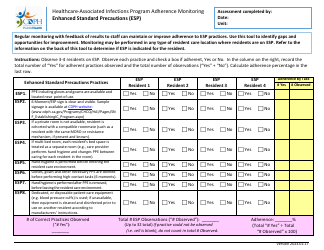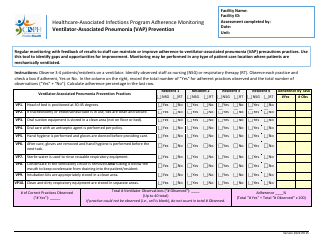Source Control and Respiratory Hygiene - Healthcare-Associated Infections Program Adherence Monitoring - California
Source Control and Respiratory Hygiene - Healthcare-Associated Infections Program Adherence Monitoring is a legal document that was released by the California Department of Public Health - a government authority operating within California.
FAQ
Q: What is source control?
A: Source control refers to measures taken to prevent the spread of infection from an infected individual to others.
Q: What is respiratory hygiene?
A: Respiratory hygiene refers to covering the mouth and nose when coughing or sneezing to prevent the spread of respiratory infections.
Q: Why is source control important in healthcare settings?
A: Source control is important in healthcare settings to prevent the spread of infections from patients to healthcare workers and other patients.
Q: What are some examples of source control measures?
A: Examples of source control measures include wearing masks, covering the mouth and nose when coughing or sneezing, and using tissue or elbow to cover the mouth when coughing or sneezing.
Q: Why is respiratory hygiene important?
A: Respiratory hygiene is important as it helps to prevent the spread of respiratory infections, such as the common cold or flu.
Q: What are some respiratory hygiene practices?
A: Some respiratory hygiene practices include covering the mouth and nose with a tissue or elbow when coughing or sneezing, disposing of used tissues properly, washing hands regularly, and wearing masks if necessary.
Q: What is the Healthcare-Associated Infections Program?
A: The Healthcare-Associated Infections Program is a program aimed at monitoring and preventing infections that are acquired in healthcare settings.
Q: Why is adherence monitoring important in healthcare-associated infections?
A: Adherence monitoring is important in healthcare-associated infections to ensure that healthcare facilities and personnel are following proper infection control practices.
Q: What does adherence monitoring involve?
A: Adherence monitoring involves assessing the compliance of healthcare facilities and personnel with infection control guidelines and protocols.
Q: What is the purpose of adherence monitoring?
A: The purpose of adherence monitoring is to identify areas where compliance with infection control practices can be improved and to prevent healthcare-associated infections from occurring.
Form Details:
- Released on October 13, 2020;
- The latest edition currently provided by the California Department of Public Health;
- Ready to use and print;
- Easy to customize;
- Compatible with most PDF-viewing applications;
- Fill out the form in our online filing application.
Download a printable version of the form by clicking the link below or browse more documents and templates provided by the California Department of Public Health.






